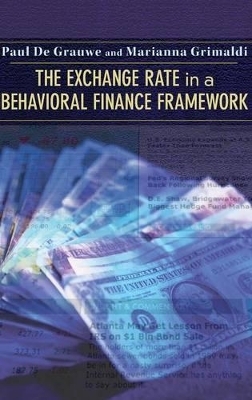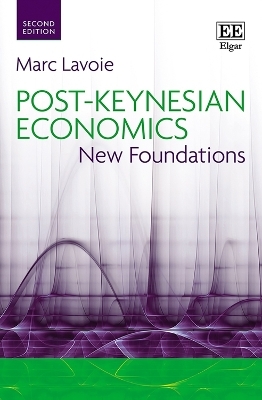
The Exchange Rate in a Behavioral Finance Framework
Princeton University Press (Verlag)
978-0-691-12163-5 (ISBN)
- Lieferbar (Termin unbekannt)
- Versandkostenfrei innerhalb Deutschlands
- Auch auf Rechnung
- Verfügbarkeit in der Filiale vor Ort prüfen
- Artikel merken
This book provides an alternative view of the workings of foreign exchange markets. The authors' modeling approach is based on the idea that agents use simple forecasting rules and switch to those rules that have been shown to be the most profitable in the past. This selection mechanism is based on trial and error and is probably the best possible strategy in an uncertain world, the authors contend. It creates a rich dynamic in the foreign exchange markets and can generate bubbles and crashes. Sensitivity to initial conditions is a pervasive force in De Grauwe and Grimaldi's model. It explains why large exchange-rate changes and volatility clustering occur. It also has important implications for understanding how the news affects the exchange rate. De Grauwe and Grimaldi conclude that news in fundamentals has an unpredictable effect on the exchange rate. Sometimes, they maintain, it alters the exchange rate considerably; at other times it has no effectwhatsoever. The authors also use their model to analyze the effects of official interventions in the foreign exchange market.
They show that simple intervention rules of the "leaning-against-the-wind" variety can be effective in eliminating bubbles and crashes in the exchange rate. They further demonstrate how, quite paradoxically, by intervening in the foreign exchange market the central bank makes the market look more efficient. Clear and comprehensive, The Exchange Rate in a Behavioral Finance Framework is a must-have for analysts in foreign exchange markets as well as students of international finance and economics.
Paul De Grauwe is Professor of International Economics at the University of Leuven, Belgium. His books include The Economics of Monetary Union and Exchange Rate Theories: Chaotic Models of the Foreign Exchange Markets. Marianna Grimaldi is an economist in the research department of the Sveriges Riksbank, Stockholm. Her research interests are international monetary relations and exchange rate economics.
Preface ix Chapter 1: The Need for a New Paradigm 1 1.1 The Rational Representative Agent Paradigm 1 1.2 Cracks in the REEM Construction 2 1.3 Behavioral Finance: A Quick Survey 8 1.4 The Broad Outlines of an Alternative Approach 10 1.5 Appendix: The Asian Disease Problem 12 Chapter 2: A Simple Behavioral Finance Model of the Exchange Rate 13 2.1 Introduction 13 2.2 The Model 14 2.3 Stochastic Simulation of the Model 19 2.4 The Steady State of the Model 25 2.5 Numerical Analysis of the Deterministic Model 27 2.6 Sensitivity Analysis of the Deterministic Model 30 2.7 Basins of Attraction 32 2.8 The Stochastic Model: Sensitivity to Initial Conditions 34 2.9 Why "Crashes" Occur 35 2.10 The Role of Memory 39 2.11 Is Chartism Evolutionarily Stable? 43 2.12 Conclusion 45 2.13 Appendix: Numerical Values of the Parameters Used in the Base Simulation 47 2.14 Appendix: Simulations of the Base Model with Different Stochastic Realizations 48 Chapter 3: A Slightly More Complex Behavioral Finance Model 49 3.1 Introduction 49 3.2 The Model 49 3.3 Stochastic Simulation of the Model 54 3.4 Solution of the Deterministic Model 54 3.5 Informational Issues 60 3.6 Some Preliminary Remarks on Empirical Predictions of the Model 63 3.7 Rational and Behavioral Bubbles 64 3.8 Conclusion 67 3.9 Appendix: The Variance Ratio ?2 f,t /? 2 c,t in the Steady State 68 3.10 Appendix: Numerical Values of the Parameters Used in the Base Simulation 69 Chapter 4: Limits to Arbitrage 71 4.1 Introduction 71 4.2 Risk Aversion and Limits to Arbitrage 71 4.3 Transaction Costs and Limits to Arbitrage 75 4.4 Conclusion 86 Chapter 5: Changes in the Perception of Risk 87 5.1 Introduction 87 5.2 Risk Perception and Misalignment 87 5.3 Risk Perception and Losses: Prospect Theory 90 5.4 Changing Risk Perception and Transaction Costs 95 5.5 Conclusion 100 Chapter 6: Modeling the Supply of Foreign Assets and the Current Account 103 6.1 Introduction 103 6.2 Stochastic Simulations of the Model 104 6.3 Deterministic Analysis of the Model 105 6.4 Sensitivity to Initial Conditions and Informational Issues 109 6.5 Profitability of Chartist and Fundamentalist Rules 111 6.6 Conclusion 111 6.7 Appendix: The Steady State of the Model 113 6.8 Appendix: Transitional Dynamics 114 Chapter 7: Risk Appetite in an Evolutionary Perspective 117 7.1 Introduction 117 7.2 The Extended Model 117 7.3 The Nature of Risk Appetite 121 7.4 Sensitivity to Initial Conditions 121 7.5 Sensitivity Analysis 122 7.6 The Effect of News 123 7.7 Conclusion 127 Chapter 8: The Empirical Evidence 129 8.1 Introduction 129 8.2 The Distribution of Returns: A Tale of Fat Tails and Excess Kurtosis 129 8.3 Dependence Properties of Returns 133 8.4 The Disconnect Puzzle 139 8.5 Transaction Costs: Do They Matter? 141 8.6 Asymmetry of Bubbles and Crashes 144 8.7 Is Chartism Evolutionarily Stable? 145 8.8 Conclusion 147 8.9 Appendix: Hill Index and Kurtosis in Prospect Model 149 8.10 Appendix: Some More Results on Volatility Clustering 150 8.11 Appendix: Additional Results for the EC Model 151 Chapter 9: Official Interventions in the Foreign Exchange Markets 153 9.1 Introduction 153 9.2 Modeling Official Interventions in the Foreign Exchange Market 154 9.3 Rule-Based Interventions in the Foreign Exchange Market 159 9.4 Target Intervention 162 9.5 Is Intervention Sustainable? 163 9.6 Conclusion 164 Chapter 10: Chaos in the Foreign Exchange Markets 167 10.1 Introduction 167 10.2 What Is Chaos? 167 10.3 Conditions for Chaos to Occur 169 10.4 Foreign Exchange Market Intervention and Chaos 175 10.5 Target Intervention 177 10.6 Empirical Relevance of Chaotic Dynamics 178 10.7 Conclusion 180 10.8 Appendix: Sensitivity to Parameter Values 181 10.9 Appendix: Intermittency Phenomenon 182 10.10 Appendix: Target Intervention with Small Target Band 183 Chapter 11: Conclusion 185 References 191 Index 197
| Erscheint lt. Verlag | 2.4.2006 |
|---|---|
| Zusatzinfo | 120 line illus. 21 tables. |
| Verlagsort | New Jersey |
| Sprache | englisch |
| Maße | 152 x 235 mm |
| Gewicht | 482 g |
| Themenwelt | Wirtschaft ► Volkswirtschaftslehre ► Finanzwissenschaft |
| ISBN-10 | 0-691-12163-X / 069112163X |
| ISBN-13 | 978-0-691-12163-5 / 9780691121635 |
| Zustand | Neuware |
| Haben Sie eine Frage zum Produkt? |
aus dem Bereich


